I think that bluebirds are my favorite wild bird, so I try to do a post each year on creating habitats for them. They live on our farm throughout the year; however, during the warmer months we generally see them around the edges of the farm fields – seldom do they make their way up to the house.
The trees surrounding the farm fields seem to give them an ideal habitat – old natural cavities for nesting and perches perfect for preying on insects in the field. We often see numerous bluebirds of varying ages while we’re out working in the field or garden during the spring, summer, and fall.
However, in the winter, the bluebirds spend time around the house, providing a treat when we’re stuck inside during cold weather. We don’t see them on the bird feeders, so I don’t think that’s what’s motivating them – I think it may be sources of open water in the house gutters. Whatever, I’m always glad to see them; they seem like such cheerful little birds.
Before the farm, when we still lived in suburbia, we didn’t have ideal habitat for bluebirds, but always tried to provide one because bluebird populations have declined so severely.
Did you know that up to six pairs of bluebirds will nest per acre and raise multiple broods per season if proper habitat can be established? We found that understanding their habitat needs and issues is fundamental to building successful bluebird habitat.
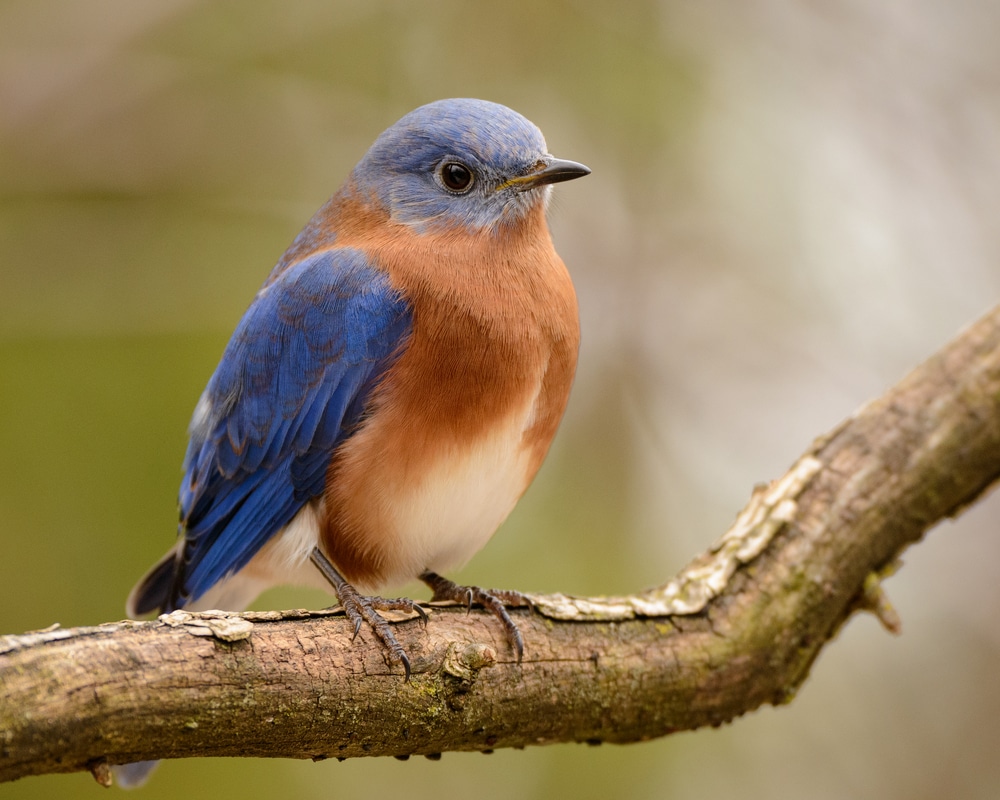
Male Eastern Bluebird
Understanding Bluebird Issues is Key to Creating Bluebird Habitat
Causes of Bluebird Decline
One of the primary causes of decline for bluebirds is the lack of nesting cavities. Bluebirds are cavity nesters so clearing trees (particularly dead and dying ones) and using metal fence posts remove the cavities bluebirds traditionally used for nests. Their beaks aren’t strong enough to excavate new nests, so they’re totally dependent on finding suitable nesting cavities.
Another cause of the decline is competition for the available nesting cavities. When house sparrows and European starlings were imported from Europe, it caused severe competition for available nesting sites. The house sparrows begin nesting very early and often take open cavities first, while the starlings (although they nest later) are so much larger than bluebirds that they forcefully evict nesting bluebirds.
Bluebirds are also targeted by predators such as house cats, raccoons, squirrels, snakes, and hawks. These animals are most often after the bluebird eggs and young.
So, placing bluebird nesting boxes in appropriate locations, deterring predators, and preventing competition from sparrows and starlings can greatly promote successful bluebird habitats. Preventing starlings is easy, simply make the next box opening 1 ½” in diameter and the starling will be too big to enter the house. For sparrows, it’s necessary to inspect the houses on a regular basis and clean out any sparrow nests before they get established. Predators can be deterred by locating a baffle below the nesting box on the mounting pole.
Bluebird Box Construction
The bluebird nesting box plan shown below was designed to meet bluebird requirements, provide easy access for cleaning, and should last many years. Use durable one-inch thick boards (such as cedar) and wood screws for construction, and it’s unnecessary to paint the house. If painting is desired, don’t use dark colors as the house could overheat in hot weather and kill eggs or young birds.
Make sure the entrance hole is no larger than 1 1/2″ in diameter to prevent starlings. Boxes should be provided with drainage and ventilation spaces. Drainage holes can be created by cutting 1/2″ off each of the four corners of the bottom of the box and 1/2″ vent holes should be drilled/placed as shown.
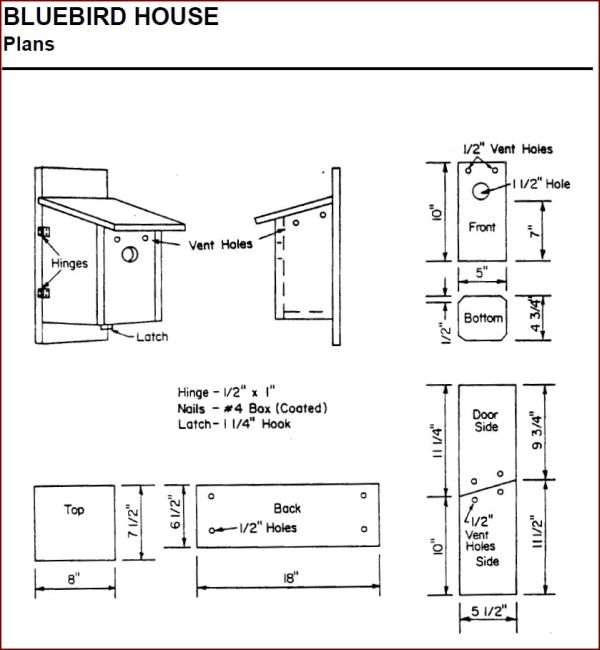
Bluebird House Plans
Bluebird House Placement
The best places for bluebird houses are reasonably open areas with scattered trees and a good distance from buildings. Bluebirds will not nest in deep woods or shade. Pasture edges, fields, lawns with trees, cemeteries, and golf courses usually make good locations.
Houses should be placed facing south or southeast with a tree located 25 to 100 feet from the front for young birds to use for their first flight. Multiple houses may be spaced 100 yards apart with screening trees or shrubs between the houses. They should be mounted 5 to 7 feet above the ground, and a smooth metal pole is better for mounting in areas where cats or other predators are problems.
Bluebird houses should not be placed in any area where insecticides or herbicides are used because this destroys the food supply and may harm the birds. Bluebirds are very susceptible to pesticides, which are thought to be one of the main causes of their historical population decline. Insecticides reduce the amount of food (insects) available to bluebirds. In addition, many insecticides and herbicides are toxic to bluebirds, especially young nestlings
The houses should be cleaned and in place by February each year to attract migrating bluebirds for bluebird nesting season. Leave them up year-round, since overwintering bluebirds use them for roosting. To ensure that they are weather-tight and clean, open the boxes after each nesting season, remove all nesting materials, and make any necessary repairs.
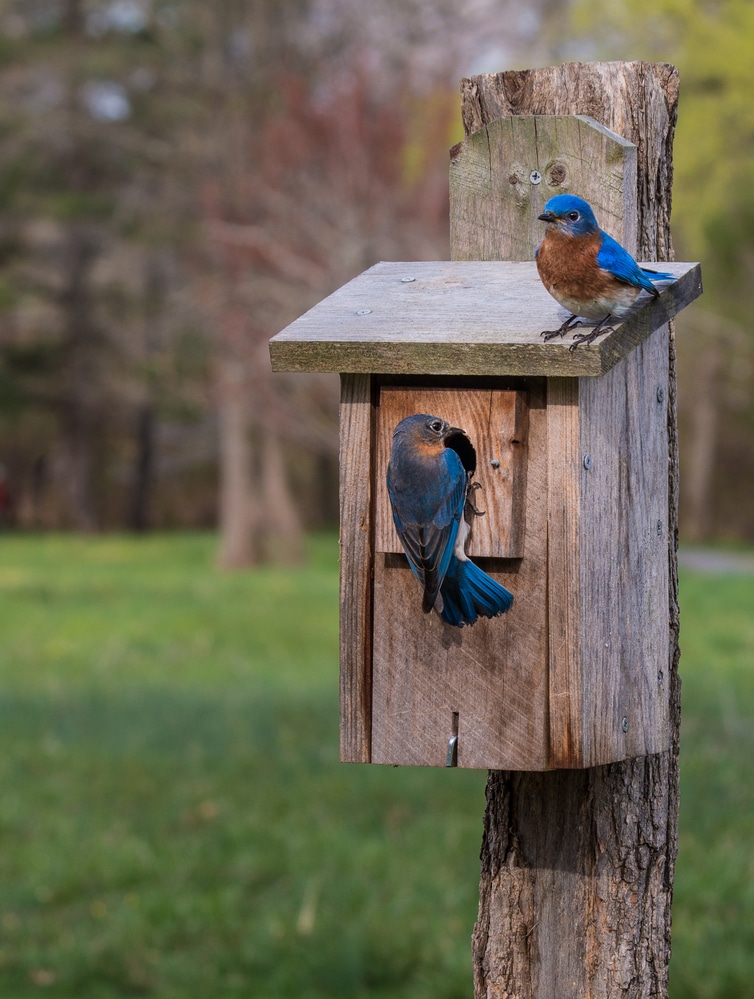
Bluebird Nesting Box with Bluebirds
Bluebird Diet for Creating Bluebird Habitat
A bluebird’s diet consists of approximately 70% insects and 30% plants; and should be considered when locating bluebird houses. Common insects consumed by bluebirds include beetles, larvae, crickets, caterpillars, grasshoppers, and spiders.
Bluebirds rely on fruit for more than 30 percent of their diet. Their favorite fruits include berries; such as raspberries, blackberries, and elderberries. All three of these grow naturally and abundantly on Bramblestone Farm and may be one reason we have lots of bluebirds.
In the winter, bluebirds depend on plant species that overwinter fruits. These include black cherry, serviceberry, sumac, dogwood, grape, honeysuckle, hackberries, bittersweet, viburnum, greenbrier, American holly, mountain ash, and pokeweed.
Bluebirds will eat from bird feeders if they’re stocked with currants, raisins, or other bits of fruit. They also enjoy mealworms.
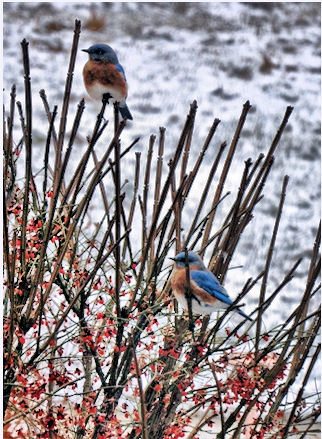
Eastern Bluebirds in Winter
Once bluebirds have taken up residence, watching the houses and removing nests as soon as young birds have left may increase the chances of a second hatch. As a minimum, the houses should be cleaned and repaired in early February each year.
Nesting boxes constructed per the directions above and properly located are usually eagerly accepted by bluebirds. We were generally successful in attracting bluebirds even when we lived in the suburbs.
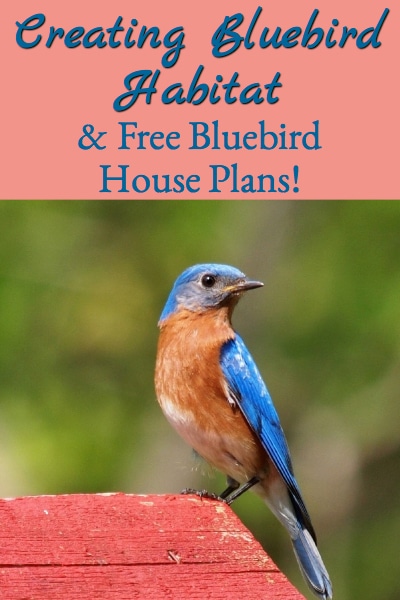
Nancy says
How do I know if the nest is a bluebird or sparrow nest?
Delores says
How do you tell the difference from a blue nest and other birds
Leeann says
We are planning our backyard landscaping with bluebirds in mind. The information you shared was very helpful. Thank you!
Lisa of Fresh Eggs Daily says
I love seeing the bluebirds. We had a lot in Virginia, I had built some houses for them and they loved our open fields. Now that we’ve moved, I need to figure out the best place for their new houses. Come spring it will be interesting if we see any. Bookmarking this post!